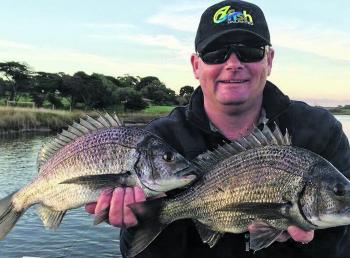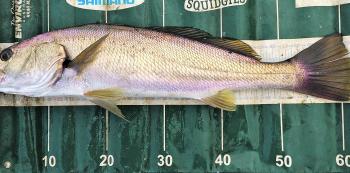July sees the cold of winter keeping some anglers off the water, but for those who are keen enough to get out and brave that cold weather, the rewards can be fantastic.
Late June and into July will see the usual seasonal behavioural patterns for winter beginning in the Glenelg River. Bream start to school up in numbers in the deeper water around 2-4m, which is their usual spawning behaviour in winter. Lower water temperatures of around 12-14° can make them a little finicky, but using your sounder to mark aggregations of fish and targeting them with soft plastics, vibes or deep diving hardbodies will usually account for some quality blue-nose bream. Baits like crab and pilchard are a great option for the bait fishers.
It’s very important to take note of tides and major bite periods so you can plan your trips around those times to give yourself the best chance of catching some of those big winter bream we see at this time every year.
Estuary perch are on the move and start to turn up in the lower estuary in winter. Perch also begin to recruit and school up in large numbers, which is also a spawning behaviour, and they are best targeted with the same techniques used for the bream in the deeper water. Often schools of EPs and bream can be found quite close together in winter and it’s not uncommon to be catching both species in the same areas. Generally, it pays to stay on the move, using your sounder to mark fish, giving them a little while, then moving on to find the next school. If you can’t seem to tempt them into taking a lure or bait, there should be plenty more schools to try.
Late May and into June saw some great mulloway captures for both bait and lure anglers, and this should only improve through July. The lower estuary has been holding good numbers of small to medium sized mulloway, with those putting in the effort with live baits and lures regularly catching good numbers of fish. The Donovans to Dry Creek area has also seen plenty of fish, with the average size being from 50-90cm, and the odd bigger fish being caught by those putting in the long hours and effort required to bump into those better fish. Soft plastics and vibes are the pick of the lures and live baits like mullet slow trolled or under a float are almost irresistible to mulloway, with live baits often accounting for the aforementioned bigger fish.
Winter often provides some of the best fishing for quality bream, estuary perch and mulloway in our rivers here in the South West, and after the flush of water from rains earlier in the year all our waterways are in great condition. Braving the cold and those early morning starts can be hard, but well worth it, so get out and soak a bait or throw some lures around and you will be well rewarded for your efforts.
Reads: 4354
Big winter bream are common in the South West.

Estuary perch are on the move to the lower estuary through winter.

Plenty of small to medium size mulloway are being caught in the Glenelg River.




